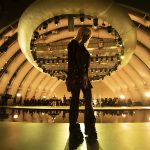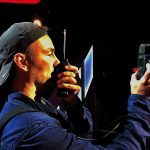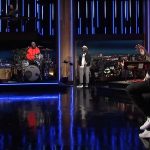Remember when MTV played music? Back when MTV launched in 1981, I was in college and procrastinated away many an hour watching music videos on the channel. Over time, MTV tried a lot of different things and reality TV was the one thing that stuck. Airing music became mostly a thing of the past, until now. In 2016, MTV brought music back in a big way when, for the first time in 20 years, they began producing a live music show called Wonderland.

A Unique Space
Wonderland is essentially a giant warehouse party that was filmed at Imperial Arts Studio, which covers a full city block in the downtown Los Angeles’ Arts District. The weekly one-hour live music show is anchored by three featured performances. Among the performers during this first season were DJ Steve Aoki, Lil Jon, Blink 182, Walk the Moon, Moxie Raia, and Rich The Kid & ILoveMakonnen; Justine Skye, Aminé and Reggie Watts; Tinashe and Ty Dolla $ign; Tove Lo, SWMRS and Anne-Marie.
The Wonderland space spans the entire block and features multiple performance areas—the Brothel, the Historic Bar and two outdoor Courtyard spaces. The producers and creative team wanted to film in a style that shared the energy of the live, warehouse party with the viewing audience, and they were aware that audience didn’t just include television viewers, but also the live streaming audience. This consideration was important in the lighting design for Wonderland, provided by LD Tom Sutherland of DX7 Design LTD. Sutherland’s team included lighting directors Craig Caserta and Jason Mack, as well as gaffer Don Winters.
“We had to create this space that could feel like you were walking into a festival in the middle of downtown L.A.,” comments Sutherland, who worked closely with Michael Downs, the scenic designer on creating the look and feel of these spaces. “We wanted it to be different — it had to be exciting, so Michael Downs created this big fake concrete wall by the entrance,” Sutherland continues. “It was lit very cold and plain on the outside, but when the guests walked in, they encountered this world of Wonderland where all of the walls were lit very colorfully; I painted color on the walls with light. We had hazers going off so we immersed them in this party or festival vibe. That was the thinking behind the base design.”
Since the creative team also wanted to keep that grungy, warehouse feel, all of the outdoor areas were all lit with PAR cans. “PAR 64s, old-school, lining every building roof,” explains Caserta. “We lined all the way around this old city block of buildings with 6-lamp bars of PAR 64s; lighting all the areas outside. Buildings in the courtyard were lit with [Vari-Lite] VL3500 Washes and VL3000 Spots. Plus, we made our own fixtures that we called GB500; they were basically a 500-Watt halogen work light that you get at Home Depot. Then we had LED tape put around the square face of it. We had a square of LED with the incandescent lamp in the center of it, which was great for area lighting. We had 75 of those made and lined the walls and the roof at various points.”

A Changing, Edgy Vibe
Sutherland and the creative team then worked on top of that base to differentiate each week’s show. “Every week, the challenge was to basically change up every area,” Sutherland says. “We never wanted Wonderland to be a place where anyone thought, ‘oh, I’ve seen this before.’ We never wanted anyone to have the same experience twice. So, we came up with different lighting concepts; things that the audience could immerse themselves in, as well as us, the creative team. We wanted to bring in all kinds of new, fresh ideas and bring excitement to both, the screen—whatever size screen they are watching—and also the people there at the performance. It was a good challenge to have each week.”
Sutherland came up with the idea of not over-lighting, but rather keeping the lighting levels lower. “We had to think how we could keep it darker and more natural. We knew that would work better,” says the designer. “If presenters are doing a walk-through of the site, we wouldn’t follow them with Litepanels. We just let it all run its natural course.
We wanted to take away the key TV elements — stripping back, and just going, ‘Let this be real. Let it be raw and edgy.’ Both from the lighting point of view as well as the camera view. We had 32 cameras; lots of which were GoPros, some strapped to people. Just using key new bits of technology to get the audience at home that much closer.”
For the interview areas, the lighting team did rig lights so they could pull people out from the background, but they really pulled back on the lighting levels. “For example, we had this bar, which had a performance area,” says Sutherland. “We did a few interviews at the end of the bar. It was just using light to pull people out; it wasn’t over-lit there. It had to feel natural, like it was just meant to happen.”
Once Sutherland and his two LDs got the base plan in place, the rest of the design followed along. “Once we all got our heads around that, it all went right,” comments Sutherland. “Once you can strip out of your head what you would usually do then you end up with something that’s really interesting and quite unique.” Sutherland also had his team prepare for the unexpected, noting, “It was a challenge. When we walked into this site — an entire block of downtown L.A. — knowing what productions are like these days and even if they say, ‘No, we’re not gonna use that area,’ you know they’re gonna use it at some stage in the filming. So you have to come up with a plan where you can light the entire site; light all the walls; make it feel like this really energetic festival nightclub-style location that they can film anywhere within.” Caserta adds, “we were able to light it very edgy and moody, and keep it really rough and not over-lit. Which was kind of fun and different, especially for television.”

The Command Ship
Since there were multiple performance venues, the programming and cueing had to be handled as efficiently as possible and give the two LDs a way to work ‘live’ during the show. “Here, the lighting designer, the lighting directors and the Vision engineering are all in one room,” Sutherland explains. “We’re not ever in the studio looking at the rig; we only see everything from the cameras’ POV. Using that as a basis, and with the multiple locations I said to Craig and the team, ‘the only way to run this is, because we can’t have you in one room, or one area, it needs to be basically just a command ship of each of us having our own individual switchable monitor and then two plasma screens in front of us all, which have previews of every camera, so we can look at wherever we need.”
Sutherland’s command ship idea was the ideal solution. “I think it really worked; it was really exciting. We were always in the one location. I was there with both the programmers, so I could call in anything and they could call in anything that they saw. It was a big collaborative team effort, especially because we never saw anything until it got dark; the first time we saw it was when we were live. Since we were all there in that environment, it just made it a lot quicker to react as well. I could say things to Craig and call scenes; it was real edge-of-your-seat stuff, but that adds to the energy and the excitement of what the show was.”
The two LDs split up the control duties. Mack dealt with all the key and area lighting, and Caserta controlled all the performance lighting. Caserta comments on the live nature of the show and the fast-pace of lighting for it. “It was quite a daunting task to keep up with everything. Every week, we would change the rig in the Brothel performance area and in the Courtyard area. One week we used a lot of [Claypaky] Sharpy Washes, and then next week we had a bunch of [Chauvet] Nexus panels. One week, we had [Highlite] Sunstrips. The next week, we had a bunch of Chauvet COLORdash bars. Every week was a different rig.”
Sutherland saw each design as individual to that artist and tailored it to their performances. “What I always try to do in my designs is to think of elements of how I can evolve and change throughout a performance,” he explains. “It’s always about having surprises, tricks and treats, here or there. So, if you tune in from one week of the series to the next, you never see the same thing twice. I want something that can evolve in a performance. For example, we had Steve Aoki on and we just literally started a song with just backlights, and then, all of a sudden, 20 lasers come on throughout the site. It’s those kinds of key moments and those surprises that I feel are essential in the design.”

Fast-Paced and Nonstop Action
The team also addressed the need to be flexible right up to taping. “Some weeks we’d have music a couple days before, but lots of it was very last minute,” Sutherland says. “Some days we would be there on the night before show day and still wouldn’t have confirmed acts for the areas. That’s where it came down to my team’s expertise and talents — they were able to put in things at a very fast pace, which on a show like this was critical. It’s knowing what each other wants, which is kind of key in these environments, and being able to trust each other. I am really thankful I had a great team who made it happen from week to week.”
For control, the team deployed two MA Lighting grandMA2 consoles. “Jason and I did everything in the same network, the same show file. We just used Worlds and separated ourselves,” Caserta says. “I’m a huge proponent of the MA2, for both live and not-live situations. Because there were so many different areas to light, when I would program, let’s say the Brothel space, I was able to just roll the console in there, plug into the network anywhere in the space and had control of the full rig. I could then go back to home base, plug into the network and run everything from there. Having the networking capabilities to be able to plug in anywhere and be able to control the whole rig from there was great. Donny [Winters] and his crew did a great job getting everything in. The venue itself is a bunch of empty buildings with no infrastructure; everything was brought in. Donny had to run cable up and through the abandoned buildings and had to figure out how to hang fixtures from the wooden ceiling.”
Another challenge was that, while the televised show had commercials, the livestream didn’t take breaks. “While we were in commercials or they were doing an interview, there were still performances going on in all the rooms,” comments Caserta. “For us, a big task was running the broadcast performance, but then also running the livestream performances. It was basically like running two shows at the same time. Having Jason there was the main solution to that. While I was doing a performance for the livestream, he was handling whatever interview was happening with the host and artists. We sat in the gallery with two multi-view monitors of all 32 cameras spread out across the city block keeping an eye on it at all times.”

MTV’s return to live music was indeed a successful marriage of their roots and a modern audience.
Michael S. Eddy, the new editor of Stage Directions magazine, continues on as a contributor to PLSN.


